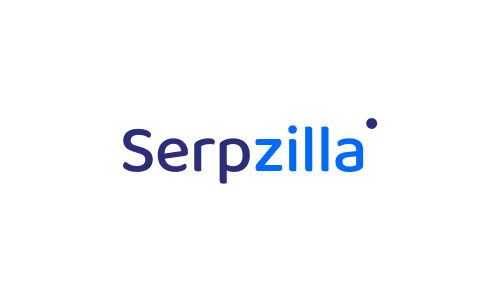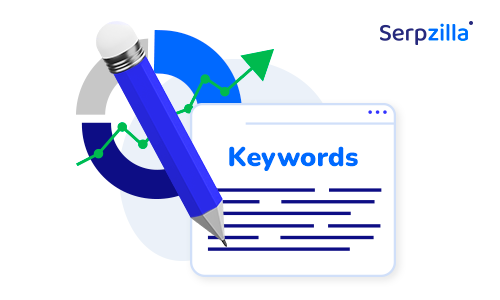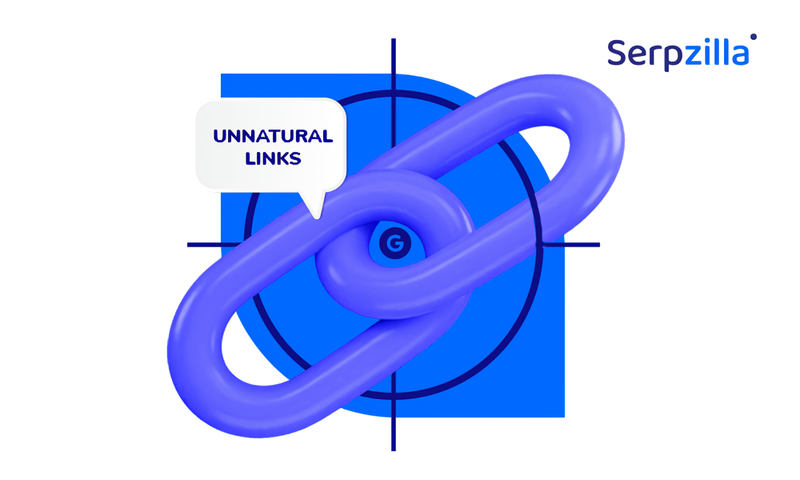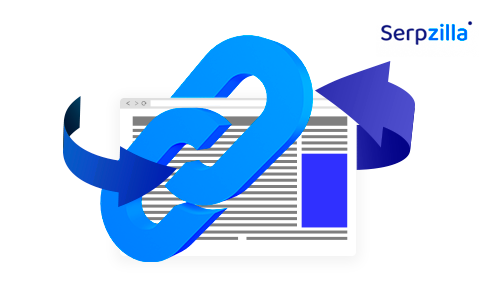When it comes to link building, everyone’s asking the same question: how many links do I need to rank? But here’s a better question to start with: how fast should you be getting them? That’s what link velocity is all about.
Get it wrong, and you risk Google seeing your growth as suspicious or unnatural. Get it right, and you’ll look like a rising authority worth rewarding.
In this article, we’ll break down what link velocity means, how to measure it, and how to improve it strategically.
What Is Link Velocity?
Link velocity is the rate at which your site gains or loses backlinks over time. Usually, it’s measured in links/ month or referring domains/ month.
It shows search engines how “naturally” your backlink profile is growing. A steady, natural-looking link velocity proves that your content is being discovered and referenced organically.
Why Link Velocity Matters for Rankings
Of course, Google looks at your total link profile. However, it also pays attention to how that profile changes and expands in popularity.
Search engines do it for a reason. If a site gets 200+ links in just one day, and then nothing happens for months, it’s just suspicious. This dynamic sends very different signals than one with steady, realistic growth. Link velocity is what helps search engines interpret these patterns and decide whether a site’s growth looks manipulative.
Here’s why link velocity matters:
- Natural growth patterns = trust. Steady link acquisition is a sign of genuine popularity and authority of your web pages.
- Sudden spikes = red flags. Google may suspect unnatural behavior and choose to devalue those links or even flag the entire site.
- Negative link velocity = ranking drops. If you’re bleeding links over time, you can expect organic visibility to suffer.
So yes, the when of your links is just as important as the where and how. Timing can mean the difference between a ranking growth and a ranking penalty.
Types of Link Velocity
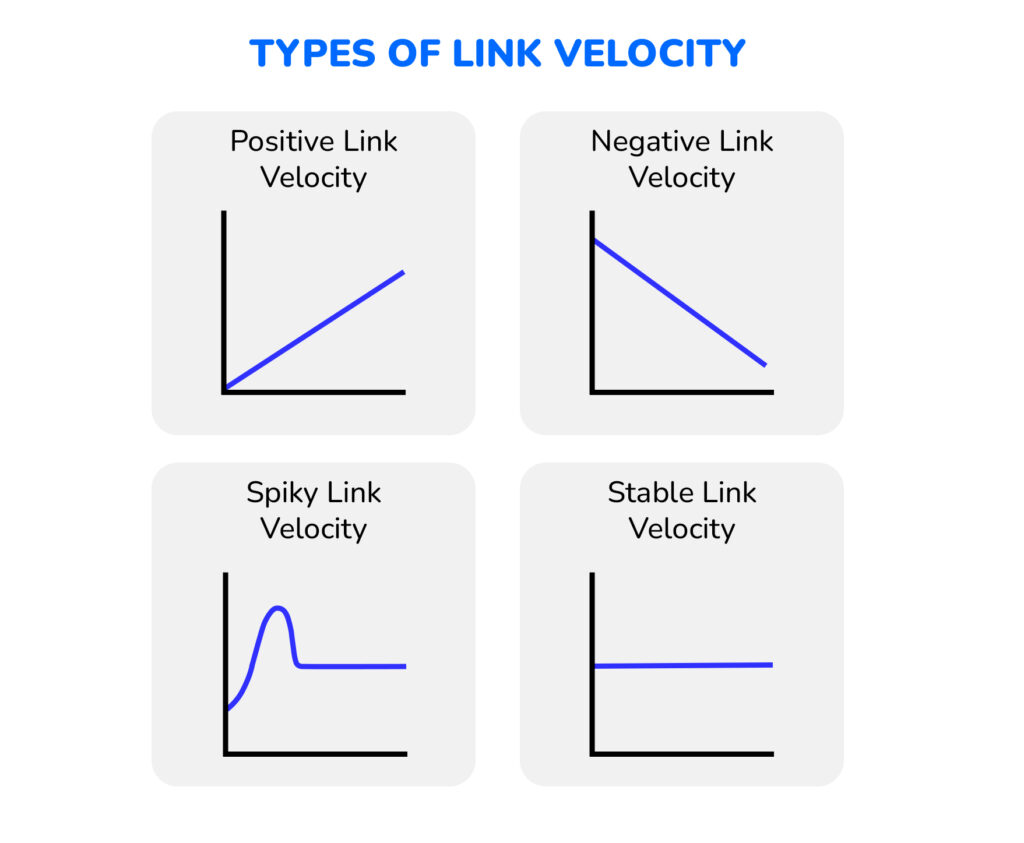
Let’s break down the four main types of link velocity and what they mean. We’ll also show how each one looks, so you can recognize the patterns.
1. Positive link velocity
This one is simple: positive link velocity shows a gradual, consistent increase in referring domains over time.
Pro tip: You can check link velocity with Ahrefs’ Site Explorer. Go to Referring domains → New & Lost, then select a time frame. A clean, rising curve with new domains each month = healthy growth.
🟢 This is a good sign. This type of velocity signals ongoing PR, content marketing, or rising brand visibility.
2. Negative link velocity
This is when your site is losing more referring domains than it’s gaining. It’s not always a penalty prediction, but it’s something you should pay attention to.
In Ahrefs, you’ll see this trend as the red bars (lost domains) consistently outweigh the green ones (new domains).
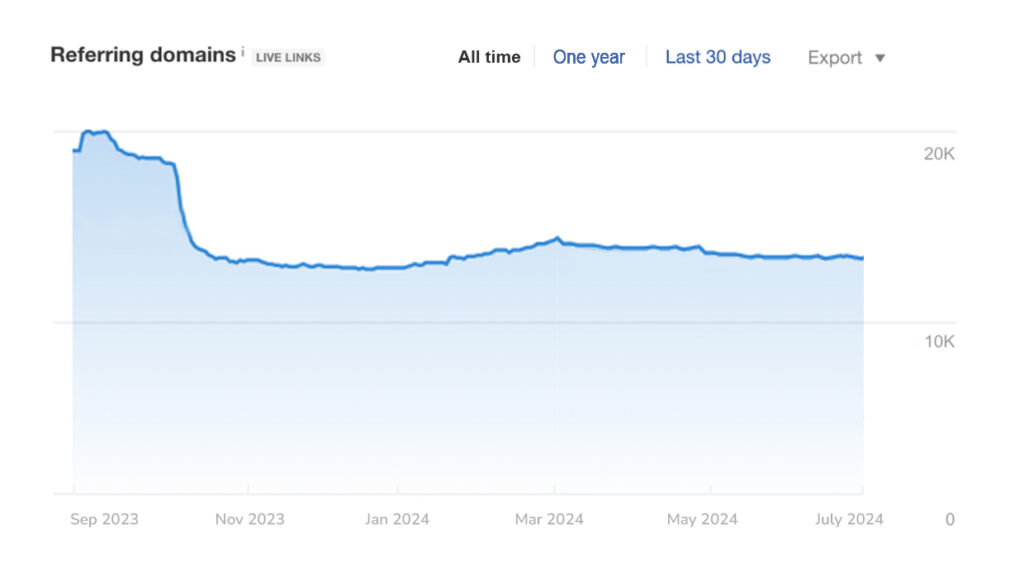
🔴 This is a risk alert. If the trend persists over several months, your site might be seen as declining in relevance.
3. Spiky link velocity
The name speaks for itself. Sharp, unnatural link spikes in velocity often result from aggressive outreach, PR events, and viral campaigns. They can also signal at paid links.
This trend shows as a sudden vertical jump in links within 1–2 days in Ahrefs’ Site Explorer.
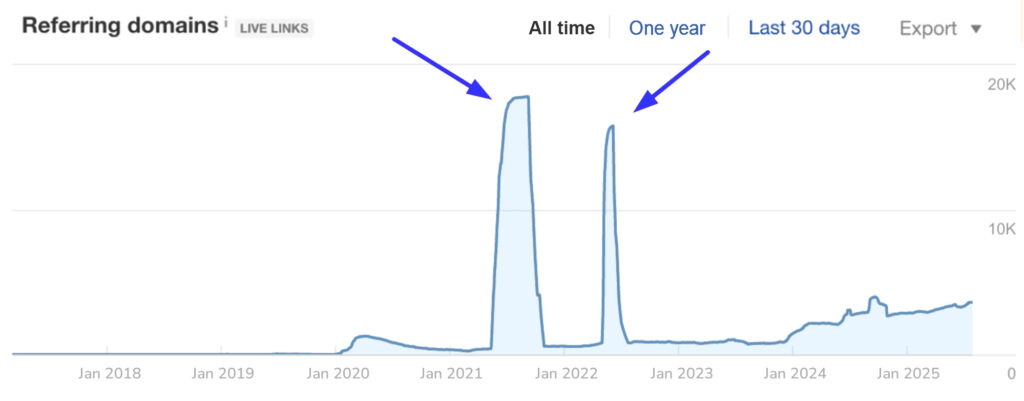
⚠️ Watch out. A spike followed by complete silence looks unnatural. If you’re running a campaign, follow up with slower, supporting link growth to soften the curve.
4. Stable link velocity
This is the ideal. A stable or slightly increasing number of links month over month is a green flag for search engines. It proves natural interest, quality content, and organic visibility of your pages.
On an Ahrefs graph, this trend will show as a smooth, steady increase in referring domains over time, with only minor fluctuations.
✅ This is your goal. Not too steep, not too flat.
How to Calculate Your Link Velocity
Calculating your link velocity is really simple. The basic formula is:

For example, if you gained 50 new referring domains and lost 10 over a month →
(50 – 10) ÷ 1 month = +40 domains/month.
Where to find the data
Again, the easiest way is to use Ahrefs.
- Go to your domain.
- Navigate to Referring domains → New & Lost.
- Set a custom date range (for example, the last 15 days).
You can use different time periods for calculation depending on your goals.
- Weekly (good for dynamic niches or short-term campaigns)
- Monthly (most common since it balances volatility and trends)
- Quarterly (best for seasonal sites or long-term analysis)
Pro tip: Always compare periods using the same length. Don’t compare one spiky week to a calm month, it’ll skew your data.
Example: Let’s say you gained 40 new links during a product launch week. That sounds great. However, if your average monthly link gain is only 15, that spike can distort your overall metrics unless you normalize it. If you were to compare that single week to a calm 30-day stretch, the launch might appear disproportionately important. Instead, calculate your weekly averages across several months to smooth out anomalies like that one big campaign.
What’s a Safe Link Velocity?
Unfortunately, there’s no universally safe number. That’s normal because link velocity is influenced by dozens of factors:
- Industry norms
- Content strategy
- Domain age
- Marketing budget
- Seasonality
- Recent algorithm updates
A SaaS startup won’t grow like a media giant, and it shouldn’t try to.
With that said, you can still rely on a rough benchmark table for context:
| Website type | Safe monthly link velocity |
| New blog | 5–15 new domains/month |
| Niche business | 15–30 |
| Scaling startup | 30–70 |
| Established brand | 70–150+ |
| Large media/content site | 200+ |
Again, these are ballpark figures.
Pro tip: The real benchmark should be your competitors. They’re already ranking for the keywords you’re targeting. That’s why their backlink growth rate gives you a realistic, niche-specific reference point for what Google considers “normal.”
Link Velocity with Competitor Backlink Analysis
So, to understand what’s safe and effective when it comes to link velocity, you need to look at the top players in your niche. Here’s how you can easily do it in Ahrefs:
- Identify your keyword cluster. Let’s say it’s “best project management tools.”
- Take the top five organic competitors. These are the pages ranking on page one.
- Plug them into Ahrefs → Referring domains → New & Lost. It’s the same algorithm you used before to look at your own link velocity.
- Export data for 1, 3, 6, and 12-month periods.
- Calculate average and maximum monthly link growth.
When you’ve collected the data, you can organize it into a concise table. You’ll be able to spot outliers, see key trends, and understand how aggressively your competitors are building links over different time frames.
Here’s an example table you can use as a template:
| Competitor | 1-month | 3-month avg | 6-month avg | 12-month avg |
| Site A | +38 | +35 | +30 | +28 |
| Site B | +22 | +19 | +17 | +16 |
| Site C | +15 | +14 | +13 | +11 |
In this example, Site A is clearly the most aggressive, while Site C is growing more slowly and steadily. These numbers give you a realistic reference for planning your own link-building timeline. Besides, you’ll avoid setting goals that are either too conservative or dangerously fast.
A smart move is to target the average velocity of the top three competitors as your initial benchmark. Then you can adjust as you see movement in rankings.
How to Do Link Velocity Safely
Wanting to get links fast is not inherently bad. Doing it without a plan is, though. Make sure that you grow your link profile without raising red flags with a few simple tips.
1. Mix your link sources
Avoid “donor mono-diets.” Combine:
- Guest posts
- Niche edits
- Directories
- Forums
- Organic outreach
- Digital PR
- Sponsored placements
Keep in mind that this process is far from exciting. Manually researching placements, checking site metrics, and logging everything in spreadsheets takes a lot of time and patience.
If you want a shortcut that saves time and reduces risk, Serpzilla can help. It’s a platform built specifically for smart, scalable link building. You can choose vetted domains across verticals, apply custom filters, and track link history before making a move. With this level of control, you’ll easily maintain a steady, realistic link acquisition pace that meets your velocity goals.
2. Diversify anchor texts
When too many links use the same anchor text, the resulting pattern can trigger spam filters. That’s why repeat anchor text is a red flag in terms of link velocity, especially in a short time frame.
Balance it with:
- Brand names
- Naked URLs
- Long-tail anchors
- Natural phrases
Pro tip: Ahrefs or tools like SEO Spyglass can help you monitor anchor distribution.
3. Avoid frontloading your campaign
Frontloading is the practice of pushing a large number of backlinks to a site in a short initial period and then letting activity drop off. It usually happens at the start of a campaign.
Imagine an SEO agency that blasts 50 links in month one, then goes silent. That’s risky. It often creates unnatural link velocity patterns that search engines can easily spot.
Take your time with campaign development. Start slow, don’t hurry, and go for consistency.
An example plan:
- Month 1: 10 links
- Month 2: 15–20
- Month 3+: 20–30/month
As you can see, you need to shoot for slow and steady growth.
Pro tip: To avoid unnatural spikes or drops in link velocity, use rental backlinks to maintain a steady backlink flow. They provide a simple way to smooth out your link graph over time, especially after frontloading. You can automate this process in Serpzilla and keep your backlink profile looking natural to search engines.
4. Match content with link growth
Google loves context. Launching new content alongside link campaigns helps it understand why those links exist.
A good idea is to publish 1–2 long-form posts, listicles, or studies monthly. Use them as link magnets. The content you publish should match your link targets. For example, if you’re building links to a product page, support it with an in-depth comparison, review, or case study.
Your goal is to gradually build a publishing calendar where each new piece of content earns attention naturally. It should fit current search demand and anchor your velocity to meaningful user engagement.
5. Monitor and adjust your efforts
Stay vigilant! Look for any sharp increases or drops in your backlink activity. Always compare those trends to changes in your search visibility. Use Ahrefs, Semrush, or Serpzilla’s link dashboard to monitor your link velocity.
If rankings improve after a period of steady growth, that’s a signal to stay the course. If the stall or drop instead, you might need to rethink your approach.
Adjust your pacing based on basic SEO metrics:
- Search visibility
- SERP movement
- Competitor actions
Check your link velocity at least once a month so you can catch unusual patterns early and respond before they impact your rankings. During active campaigns, you’ll want to look into these details more actively and frequently.
Final Word
Link velocity is a trust signal. A steady pace of relevant, high-quality backlinks tells search engines your content is valuable and worth ranking.
It can be tempting to push hard at the start or follow hot link-building trends, but you risk wasting time, money, and credibility. Use link velocity as your strategic edge. Instead of blindly chasing backlinks, you can build a timeline that mirrors proven growth patterns in your niche. Play the long game!
If you want to skip the tedious parts like hunting for good placements or checking link history manually, use Serpzilla. We’ll help you stay safe, scale wisely, and save hours while maintaining healthy link velocity.



